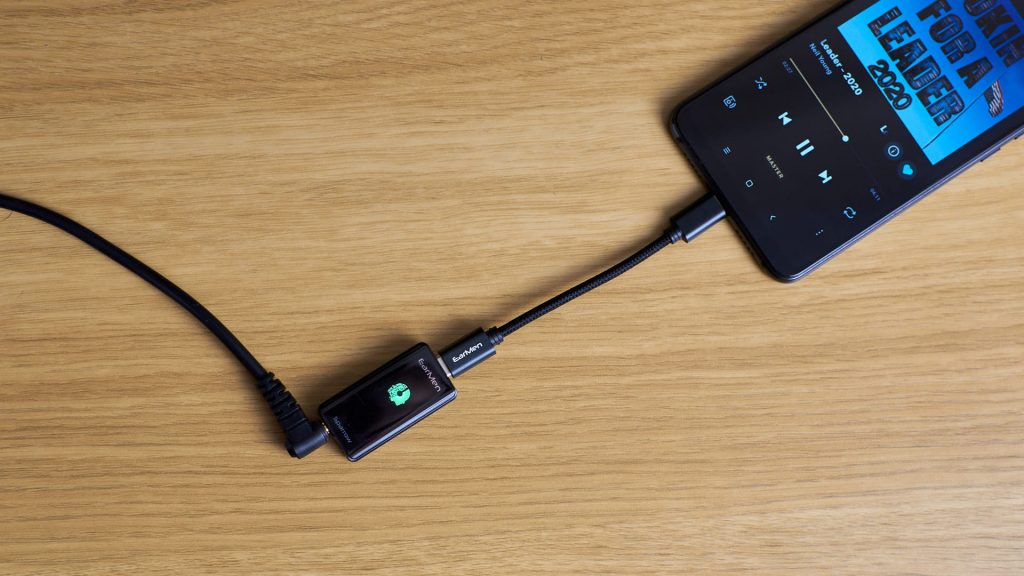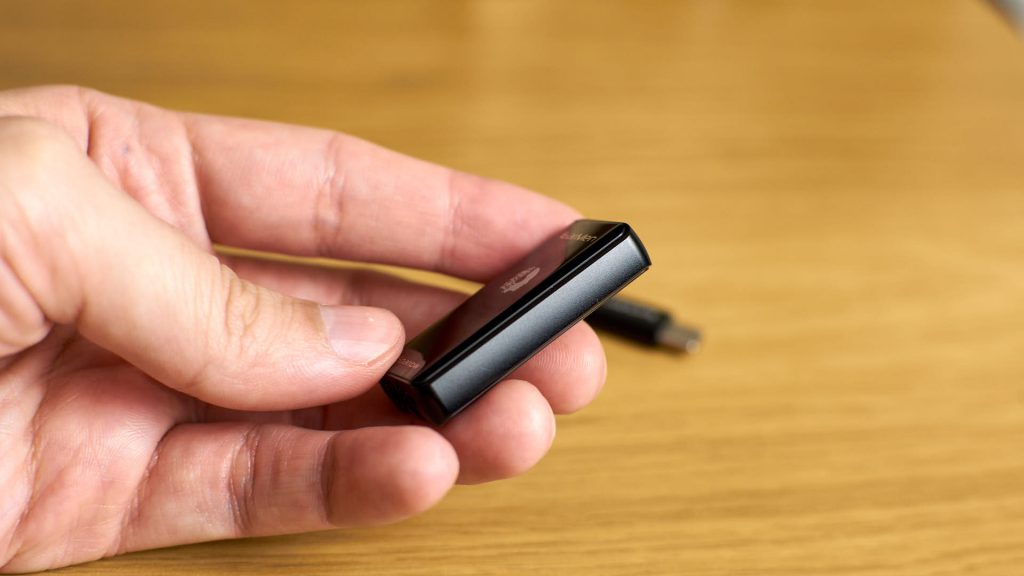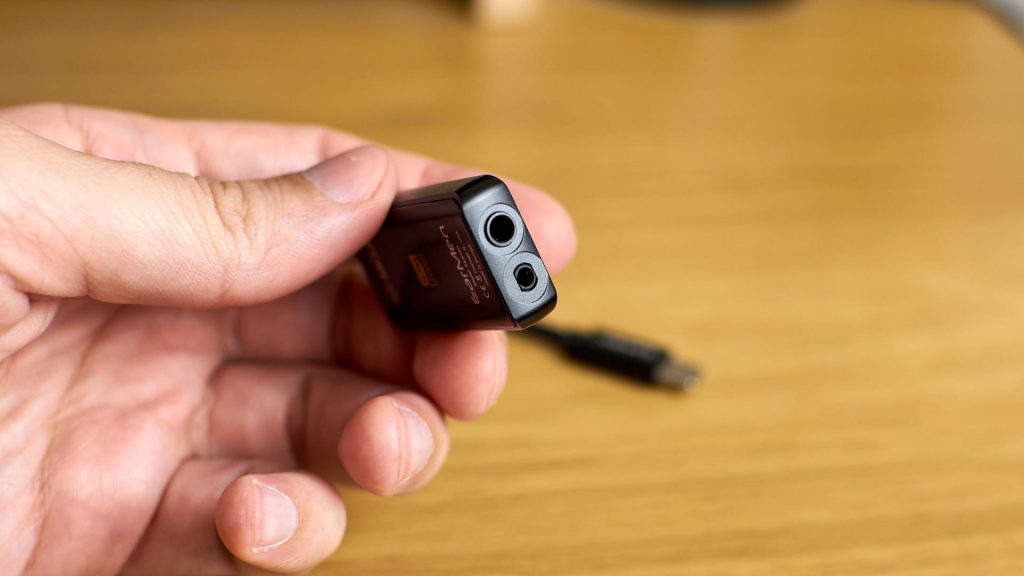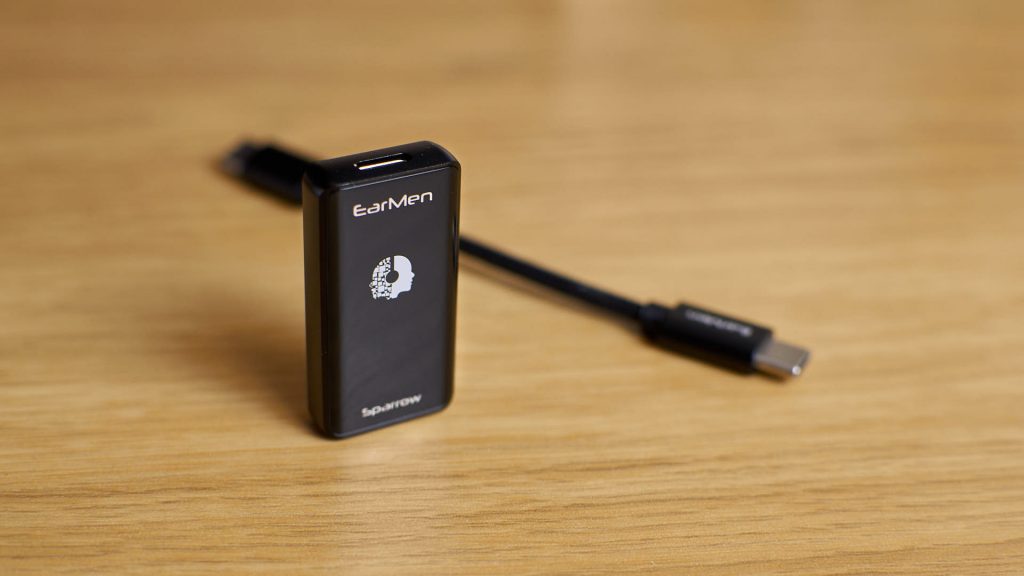Sparrow is a portable DAC brought by EarMen – a quite fresh brand on the market, but I have to say they entered it with aplomb. While writing this article, one of the brand’s first products TR-Amp is sitting on my desk and juicing my headphones. It really says something about the product when you don’t want to stop using it after the review is done.
But today, it’s about finding out if EarMen can repeat its success with a truly portable and tiny device. Let’s dig in.
Build and Package
A lot of devices call themselves portable nowadays, but sticking a battery into something doesn’t really make it all that portable, does it? Well maybe to some degree, carrying mentioned TR-Amp or Chord Mojo with my laptop is quite OK, but carrying those slabs in my pockets is a completely different story – neither my pockets nor patience is that stretchy.
On the other hand, I find the Audioquest DragonFly family to be proper portable devices. EarMen Sparrow is even a bit more compact than that. It’s tiny and lightweight but the use of quality materials means it doesn’t feel cheap. On the contrary, it looks very slick and feels like a well-built product.
The Package is very simple, there’s the DAC itself and two USB cables. The USB-C one to connect it to your smartphone, and the USB-A one that’s standard on all our PCs. If you’re an Apple user, you’ll have to buy additional cable, or maybe nicely ask your favorite brand to start following industry standards for once.
Features and Connectivity
EarMen Sparrow is based around Sabre’s ES9281PRO D/A converter that offers wide format support, including the increasingly more popular MQA decoding. Aside from that, it’ll take PCM and DXD up to 384 kHz, as well as DSD up to 128 DoP.
Being this small means there’s usually not much to talk about in this section, but Sparrow packs one important surprise. There’s one input in form of USB-C, but there are two outputs to choose from. One is your normal single-ended 3.5 mm stereo jack that offers up to 2.0 Vrms, while the other one is a balanced 2.5 mm output that’ll go up to 4.0 Vrms in 600 Ohms. This second one makes all the difference when talking about this unit, but more about it in a sound quality section.
Sparrow doesn’t have any controls, it’s powered automatically when connected while the volume is controlled via the player. It lights with four different colors signifying different states of operation, but I’ll not go into the details here – it’s in the user manual anyway.
Sound (Single-ended Out)
Firstly, I connected a great in-ear model Kinera Freya to the 3.5 mm socket and started browsing through my favorite songs. Sparrow treated me with a full-bodied and punchy sound. Its overall character was very neutral and no emphasis on any region could be detected. Bass depth and control were great, while the soundstage was adequate.
Moving to my bigger Hifimans I realized there’s enough power in the small Sparrow to drive them in a satisfying manner. Control over the baseline was good, vocals sounded full and present, and dynamics left nothing to complain about. If there’s one area I wished a bit more, it was the highest register. Even though Sparrow is capable of crisp detailing, I felt some air from the acoustic and live recordings missing. But overall, I was very happy with the presentation that proved to be better controlled, cleaner, and more dynamic than DragonFly Black. Unfortunately, I didn’t have DF Red on hand for a direct comparison, which would make more sense since they’re priced equally. Going solely by my memory, and using Black as an intermediate device I’ve heard next to both, I’ll go on a limb here and say that Sparrow wouldn’t have much problem taking on Red either.

Logo lights in four different colors.
Sound (Balanced Out)
I switched my cable then and moved to a balanced output. Oh my, that was an experience you don’t have every day. The soundstage opened with greater transparency being evident all over the frequency range. Bassline gained more grip and texture, transients became crisper and notes richer with micro-details. You remember how I said that air is lacking up top with SE output, well forget about that complaint cause it’s gone. The highest register just lit every recording with a fresh amount of air and allowed instruments to breathe.
Listening to the Every Morning by Keb’ Mo’ I immediately noticed how much wider and spacious the soundstage has gotten. Guitar strings plucked with more zest and intent making me nod my head along with this slow but soulful tune. Moving to a faster Madness by Muse confirmed the superior grip over bass notes, composure, and layering of balanced output. Keeping the rhythm and fast pace was made to look like an easy task by this small unit.
At this moment, I felt Sparrow is leaving both Red and Black Dragonflies in the mirror. In some areas, such as sheer transparency and pacing, it is even surpassing its older brother TR-Amp. Commendable achievement.
Conclusion
EarMen Sparrow is a truly portable device you can carry around in your pocket. Knowing this, we usually apply a lower set of standards the device has to measure up to. Over the single-ended output, Sparrow fulfills these with flying colors, matching and even surpassing the aging competition. Switch to its balanced output, however, and it surpasses the expected in the most spectacular way. While you still can’t expect physics to suddenly bend and this tiny unit to pour incredible amounts of power, the sheer sound quality to size ratio is just astonishing.
. . .
UPDATE: Some users reported hearing random clicking noise for a minute when Sparrow is connected to the phone. I had a similar experience with one of my players (HiBy Music) but couldn’t replicate it with the Tidal app and another phone (with its default player) so I assumed it was a HiBy player-specific issue. It seems however than this might be an issue with a wider selection of phones/players. Thanks to all who brought it to attention, I’ve already notified the manufacturer and will keep you updated if there’s any new info about it.
UPDATE 2: EarMen has released a firmware update that solved the clicking issue. Both firmware and tool needed to flash it onto your device are available for download on the official page.
| EARMEN SPARROW – CHARACTERISTICS |
|
DAC: Sabre ES9281PRO Outputs: Signal level: Formats support: |
| EARMEN SPARROW – CHARACTERISTICS |
|
DAC: Sabre ES9281PRO Outputs: Signal level: Formats support: |










Popravi u tabeli drugi red
stoji : Sound quality (single ended)
a treba : (balanced)
Poz
Ispravljeno, hvala!
I added single ended twice in the marks section.
Fixed, thanks!
Hi, which headphones did you use for balanced listening? Which headphone with balanced under $1000 do you recommend pairing with the Sparrow? Will I needing an adapter? Thanks.
Sorry for seeing this comment so late… I used Hifiman HE4XX with my own handmade balanced cable. Manufacturers usually provide single-ended ones in the box so you’d have to purchase a balanced one yourself. It’s just important that headphones have fully separated left and right channels (two wires for each side) like all Hifimans do for example.
Hi! Nice review! Can you tell me the difference between Earmen Sparrow and IFI Hip Dac? I can’t find any comparison…
I bought the sparrow a few weeks after purchasing the Hip Dac. I loved the hip dac – great warm sound – but didn’t use it after I started listening to the sparrow, so sold it on ebay. SQ, usability and portability won me over.
Hello ,very good review.I hesitate between the sparrow and lotoo Paw S1 (all with balanced output)?Did you try the 2nd one?Thanks
I haven’t tried it so can’t really be of help here.